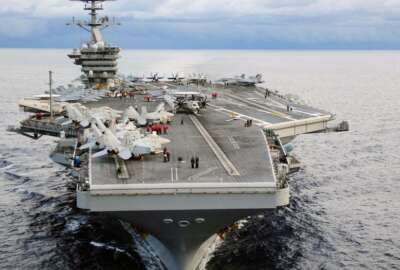GAO advises Navy to be balanced as it acquires new unmanned ships
The Navy plans to spend billions to acquire a variety of umanned ships of all sizes, 21 in all over the next five years. The Government Accountability Office ad...
Best listening experience is on Chrome, Firefox or Safari. Subscribe to Federal Drive’s daily audio interviews on Apple Podcasts or PodcastOne.
The Navy plans to spend billions to acquire a variety of umanned ships of all sizes, 21 in all over the next five years. The Government Accountability Office advised Navy officials to take a portfolio approach to bring more efficiency and balance to the program. The Federal Drive with Tom Temin heard more from the GAO’s director of contracting and national security acquisitions Shelby Oakley.
Interview transcript:
Tom Temin: Ms. Oakley, good to have you back.
Shelby Oakley: Appreciate you having me.
Tom Temin: And I recently spoke with one of the program officials and they have several programs going in parallel, according to the size of the vessel. And they range from pretty small to almost as big as destroyers. And what is the problem with the way that they’re going about this that GAO fundamentally sees here?
Shelby Oakley: Fundamentally, we see that the Navy really lacks a portfolio based approach to these systems. And so while many of these systems, you know, like the large unmanned surface vessel or the medium unmanned surface vessel are managed by the same PEO, there are other aspects of this uncrewed effort that are critical to achieving the intended capabilities. And that includes things like what we call the digital infrastructure, the, you know, things that will drive the automation and artificial intelligence to be able to achieve these intended capabilities. And those are not managed as part of the program efforts, despite the fact that they’re going to be vital to these platforms, these systems being able to achieve what they’re intended to achieve.
By the Navy taking a more portfolio based approach, they would be able to better manage risk across this uncrewed systems enterprise by understanding kind of the progress of the digital infrastructure, understanding how they can, you know, balance and manage their efforts to be able to achieve capability faster.
Tom Temin: And a portfolio based approach, what would that change? What does that mean, in terms of how they do their day to day development activities here?
Shelby Oakley: Yeah, that would mean that there is somebody in charge, right of the entirety of the effort that has kind of the resources, decision making authority to be able to, you know, reprioritize, and make decisions across the portfolio. You know, one of the outcomes that we’ve seen of not managing it this way is that this digital infrastructure hasn’t gotten the investment, hasn’t gotten the resources that it’s needed to keep pace with the development of the platforms. And as I mentioned, these platforms need this digital infrastructure to be able to achieve their intended purposes.
Tom Temin: Right. Otherwise, they just end up as unconnected floating things with nobody on board.
Shelby Oakley: Absolutely.
Tom Temin: And that digital infrastructure, is it your view that really, there should be one basic digital infrastructure to encompass all of these? Otherwise, don’t they risk interoperability problems, and just duplication of effort problems? If there’s a different network and a different set of protocols, etc, etc. for each class of vessel, they hope to float or have undersea?
Shelby Oakley: Yeah, you know, it’s not my vision, it’s the Navy’s vision that that digital infrastructure would provide that kind of common operating communications, AI-based capabilities for this fleet of uncrewed systems. And so that’s why it’s so important that you know, it be managed at a portfolio level so that because of the effects that it’s going to have on all of the systems and the way that it’s needed for all those systems. So you know, this digital infrastructure is going to enable the Navy to develop the autonomy, using artificial intelligence, to be able to kind of keep refining and adding capabilities to these systems. So you know, you’re familiar with iterative, agile approaches to development, that’s exactly what this digital infrastructure is going to enable for the Navy, that the Navy intends.
Tom Temin: We’re speaking with Shelby Oakley, director of contracting and national security acquisitions at the Government Accountability Office. And there’s also something overlooked about these, which also mitigates in favor of having some kind of a unified and interoperable digital infrastructure. And that is, even though they’re uncrewed, or unmanned, they’re not autonomous. That is to say, somebody is driving that vessel, they’re just not sitting aboard it. And there are mechanisms to evade and shoot if someone tries to abort it, and so on. So I would think that the people that are operating have to make sure that they can communicate with one another, as much as the vessels need to communicate with one another for coordination.
Shelby Oakley: Yeah, absolutely. But in the long run, that’s what the Navy envisions that they’re not remote control that there is a very limited need for human intervention in these systems, right. And that’s where the artificial intelligence comes into play and the importance of, you know, data collection and algorithms to be able to enable that artificial intelligence so that decisions can be made by the system and not by the human.
Tom Temin: And does their vision include to even firing decisions? That is weapons deployment decisions?
Shelby Oakley: Not yet. And that’s one of the things that the Navy really highlights as a key challenge and a key area for continued understanding, right? Because there’s ethical considerations and all sorts of things that come into play when you talk about remote firing, or artificial intelligence firing of weapons. And so in the Navy’s unmanned campaign plan, there’s a broad discussion about the ethical considerations and legal considerations that need to be worked out if that would be the eventual goal.
Tom Temin: And if they don’t have a portfolio approach to development of these systems, what do they have? A separate person over each of the they sound almost like ketchup sizes, small, medium, large and extra large?
Shelby Oakley: Exactly. There’s different stakeholders, different folks in charge of different aspects of the program. And so while several of the programs are managed under the same PEO, not everything is managed under there, and the digital infrastructure is being managed completely separately. And so that’s where we see an opportunity for the Navy to really employ these portfolio management practices and be able to bring a holistic view to the effort itself. And, you know, I have to say the Navy has developed this unmanned task force, which it sees as doing some of those things. But you know, how it is Tom, where the resources are, is where the decision making lies, right. And so being able to kind of control resources and control decision making, I think is going to be key to be able to make strategic portfolio based decisions and keep these uncrewed efforts moving forward.
Tom Temin: And at some point, this moves out of development into maybe multiple copy acquisitions. And I would think that the portfolio management then would make the eventual acquisition simpler, and easier and maybe more competitive.
Shelby Oakley: Yeah, it would certainly provide more insight into the readiness of the programs to move into that acquisition phase, and then eventually how they will be developed, sustained operated. And so, you know, we definitely see the work that the Navy is doing with regard to prototyping as super important and really positive. But they do have some opportunities to bring better practices to their prototyping, such as through portfolio management, but also through developing more credible plans for their prototyping efforts to show decision makers how they’re using those efforts to mature technologies, and how they’re developing measurable criteria to be able to show that they’re going to meet the strategic objectives, and that they’re ready to transition to those acquisition programs, where there will be increasing dollars invested.
Tom Temin: And review your main recommendations and whether the Navy accepted them.
Shelby Oakley: Yeah, we made several recommendations to push the Navy forward and bring more fidelity to these efforts overall. We have some recommendations focused on their cost estimating because as it stands, the money that they have identified that they’re planning to spend over the next five years, a little over $4 billion, doesn’t even include the digital infrastructure or the cost to operate and sustain these systems. As we’ve been talking about, we made recommendations related to pushing the Navy to manage these systems as a portfolio and to identify measurable criteria for that portfolio so that the Navy can understand if it’s achieving its strategic objectives for these programs. And then finally, really, we keyed in our recommendations on those prototyping planning efforts. We need to see more information about milestone and schedules and criteria that would enable the Navy to make good informed investment decisions about transitioning these programs to acquisition programs of record.
Tom Temin: And just getting back one more time to that digital infrastructure idea. That could prove to be the thorniest part of development here. Because if you look at other systems and platforms that have been highly software intensive, it’s always the software that trips them up.
Shelby Oakley: You’ve hit the nail on the head right there, it’s going to be the biggest challenge. You know, the digital infrastructure really requires people, lots of data collection and repository analytics, algorithm development, modeling and simulation to be able to develop and provide, you know, these AI capabilities that are based on automation. And so it’s a huge effort. And it’s a big challenge. And I think that’s why we raise the issue that you know, the Navy is a little bit behind in that. And so focusing on the platforms versus the digital infrastructure has been what has been the case. Now, as we hear it, the budget when we get the details that come out, we understand there’s going to be more of an emphasis on funding those digital infrastructure efforts. But really, that’s where the capabilities lie.
Tom Temin: Shelby Oakley is director of contracting and national security acquisitions at the Government Accountability Office. As always, thanks so much for joining me.
Shelby Oakley: Thank you so much.
Copyright © 2024 Federal News Network. All rights reserved. This website is not intended for users located within the European Economic Area.
Tom Temin is host of the Federal Drive and has been providing insight on federal technology and management issues for more than 30 years.
Follow @tteminWFED






